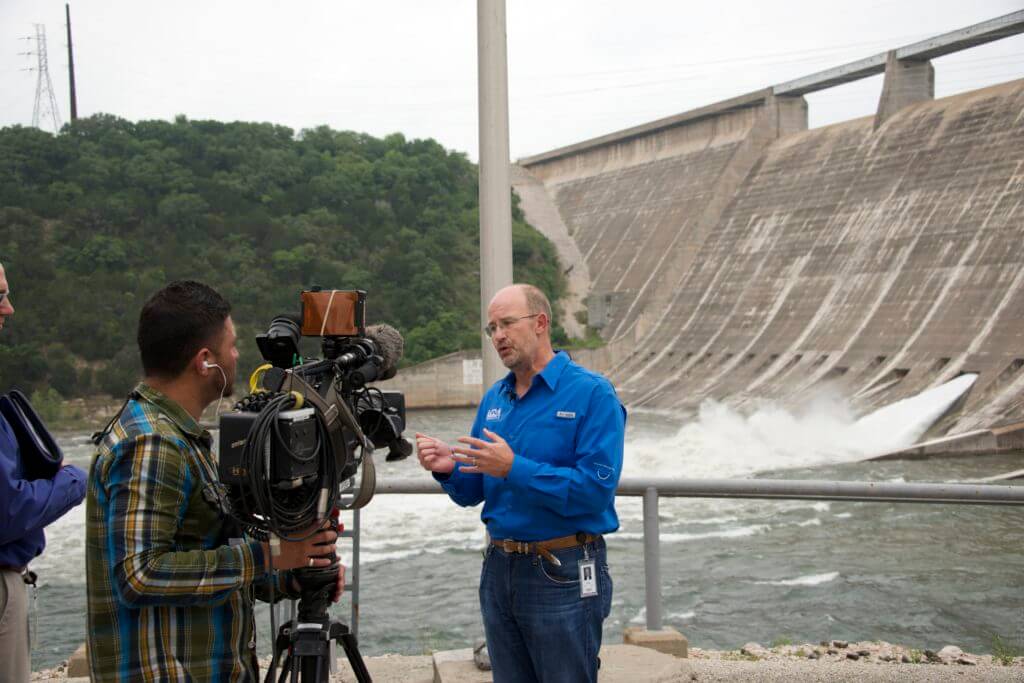By SARAH DOOLITTLE, Four Points News
Thanks to recent rains, all six lakes along the Highland Lakes chain managed by the Lower Colorado River Authority are now at 100 percent of capacity after a prolonged drought from late 2010 to early 2015.
On Thursday, hydroelectric operations began at Mansfield Dam to produce electrical power through the use of the gravitational force of falling or flowing water. And on Monday, LCRA opened one floodgate in the dam.
“The rain in the Highland Lakes watershed has been more than lakes Buchanan and Travis can safely hold without allowing levels to rise significantly higher in the flood pool on Lake Travis,” said Clara Tuma, LCRA spokesperson.
The opening of the floodgate at 8 a.m. on Apr. 25 attracted a crowd of nearly two hundred, according to LCRA security officers stationed at a platform the base of the dam. LCRA temporarily opened the platform to allow public viewing of the opened spillway, and hundreds visited throughout the day on Monday to view and photograph this rare event.

LCRA general manager Phil Wilson speaks with media at Mansfield Dam on Monday, when one of the floodgates was opened. Hundreds of people came out to watch the event. Wilson, a local Four Points resident, was encouraged to see so many kids watching the event and seeing first hand how a dam works.
This is the first time floodgates in Mansfield Dam have been opened since 2007. Lake Travis last reached levels above 681 feet (above sea level) in May 2010.
Once Lake Travis reaches 681 feet, it is considered full.
“At that level, the lake contains 1.1 million acre-feet of water in its conservation pool,” Tuma said.
Beyond that level, there is what LCRA calls a “flood pool” capacity of an additional 787,000 acre feet of water that extends to the top, or spillway, of Mansfield Dam at 714 feet.
At that level, public facilities like Cypress Creek Park, operated by Travis County and located on the shores of Lake Travis on Bullick Hollow Rd., would be fully submerged. Current levels mean that the park, which for the past five years has been a dry expanse of grass and trees, are once again waterfront and frequented by boaters, swimmers and those who like to fish.
Measures put in place by LCRA, which manages the Highland Lakes chain, manage the flow of water through the lakes chain to prevent flooding downstream in Austin and beyond.
“LCRA works to manage floodwaters by holding or moving water as needed through a series of dams along the Highland Lakes. Of the six Highland Lakes, only Lake Travis – formed by Mansfield Dam – is designed to hold back floodwaters that otherwise would flood Austin and downstream communities,” Tuma said.
Last year’s rainfall brought the second wettest year on record, and though a La Niña is predicted to bring a drier fall, for now LCRA is working hard to manage the flow of water and to prevent further flooding in communities downstream of the lakes chain.
“Waiting until Monday morning to begin floodgate operations at Mansfield Dam (allowed) floodwaters in the river below Austin to further subside in the lower basin. Discharges from the Highland Lakes will reach the lower basin in five to seven days, and will not contribute to current flooding in the area,” explained Tuma.
She also emphasized that the opening of the floodgate in Mansfield Dam, expected to continue until Wednesday, Apr. 27, will create swift water conditions in Lake Austin, and that, “anyone near the lakes should use extreme caution.”
According to the U.S. Drought Monitor, published by the National Drought Mitigation Center at the University of Nebraska, Lincoln, all of Central Texas is no longer in a drought.
That does not mean, though, that local residents should change water conservation habits learned during the drought, The greater metropolitan Austin area is still one of the fastest growing in the country.
“The Highland Lakes supply water for more than 1 million people, businesses and industries, the environment, and agriculture in the lower Colorado River basin,” emphasized Tuma. “It’s important for everyone to keep using water wisely. We have enough water, but we don’t have enough water to waste.”

